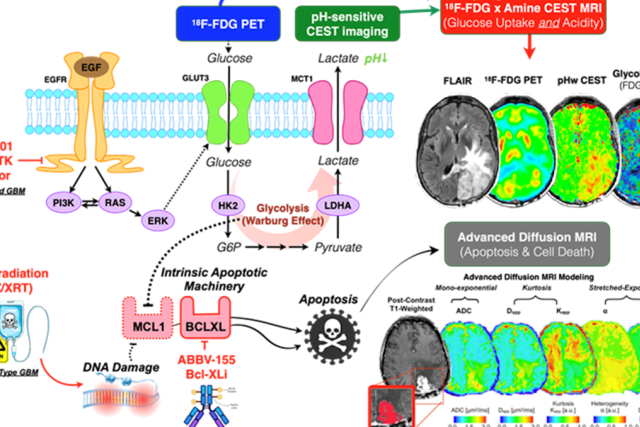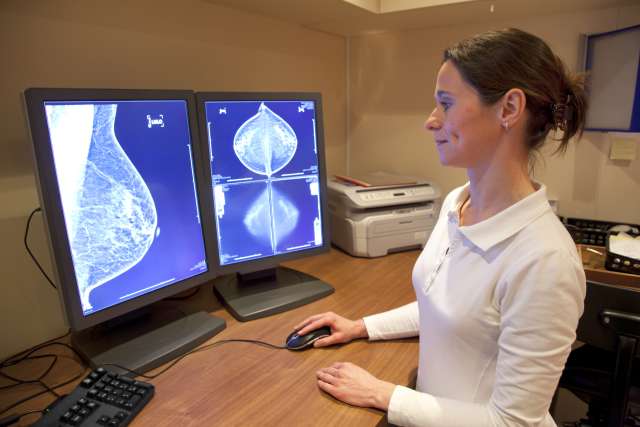Photo: A graphic from SPORE project 2. (UCLA Brain Tumor Center)
Brain cancer researchers at the UCLA Jonsson Comprehensive Cancer Center have been awarded another $11 million for their work on overcoming the resistance to treatment that makes glioblastoma so deadly.
The National Cancer Institute (NCI) has renewed UCLA’s funding as a Specialized Program of Oncologic Research Excellence in brain cancer for a second five-year term. The goal of the program is to rapidly translate new scientific discoveries into early-phase clinical trials, says Linda M. Liau, MD, PhD, professor and chair of Neurosurgery at the David Geffen School of Medicine at UCLA.
The award will take three projects developed from prior SPORE funding into clinical trials and develop new research areas.
“What’s unique about the SPORE is that this award is only given to institutions that are able not just to run clinical trials, but those that can discover new scientific insights and develop them into novel therapies for patients,” says Dr. Liau, who is principal investigator and program director of the UCLA SPORE in Brain Cancer. “We’re able to take things directly from the lab to first-in-human clinical trials.”
Resistance to treatment
Glioblastoma is an aggressive cancer that occurs in the brain. The median survival for a person diagnosed with glioblastoma is currently still less than two years, with a five-year survival rate of less than 5%.
It is one of the few cancers without effective treatments because of its heterogenous nature, as well as the problem of treatment resistance that may result from treatment itself.
“It’s not that we don’t have treatments; they’re just not curative because these tumor cells mutate and change over time,” Dr. Liau says. “That’s what we’re trying to tackle. If we are able to predict and treat these tumors before they become resistant to the current therapies, that would be very meaningful to patients.”
Dr. Liau says treatment resistance can be caused by the therapy itself, including radiation, chemotherapy and immunotherapy.
“For instance, when giving immunotherapies, we can induce T cells that go attack the tumor,” she says. “But this can trigger a new population of immune suppressor cells that attack the T cells. Even though we’re inducing an immune response against tumors cells, the body is fighting back to protect against an immune attack in the brain.”
The UCLA Brain Tumor Center was first awarded NCI SPORE designation in 2017, with an initial grant of $11.4 million. This latest five-year round will continue to fund three of the main projects initially started during the prior funding cycle, as well as career enhancement programs and developmental research projects centering on novel therapies, including development of bispecific CAR-T immunotherapies against glioblastoma and a new vaccine for G34-mutated pediatric brain tumors.
Clinical trials
Dr. Liau says the three trials are each led by a basic scientist and a clinician to combine the insights that come from the lab with the experience of treating glioblastoma patients.
In a trial now underway, a dendritic cell vaccine is made from a participant’s own tumor tissue and combined with an anti-PD1 immune checkpoint inhibitor to counter resistance when either treatment is used alone. The checkpoint drugs work by blocking the proteins that stop the immune system from attacking cancer cells.
“What I’m excited about is that we’re seeing a growing number of long-term survivors in our patients treated with immunotherapy combinations,” Dr. Liau says. “We’re seeing some patients with certain combination immunotherapies that are living for many more years than would be expected. Currently, we’re trying to find out what combination works best and for which patients.”
Another trial, which is expected to start within six months, will look at combinations of drugs to make radiation-resistant tumor cells become sensitive to radiation. Investigators have found that commonly used drugs for anxiety (e.g., quetiapine) and high cholesterol (e.g., atorvastatin) seem to make glioblastoma cells more sensitive to radiation. Participants will undergo radiation and controlled combinations of these medications.
Phioanh “Leia” Nghiemphu, MD, professor of clinical neurology and one of the principal investigators, says people whose glioblastoma has come back will be eligible for the trial.
“The recurrence setting is when it’s harder to treat these tumors,” Dr. Nghiemphu says. “My hope is that we can duplicate the success we’ve seen in animal models where we actually see mice living longer when they get the combination with radiation than with just radiation alone.”
Dr. Nghiemphu says the medications’ potential to sensitize glioblastoma cells were identified through a lab screening conducted by her collaborator, , MD, PhD.
“It’s very good because we don’t have to go through millions of dollars of drug development,” she says. “It’s always nice to repurpose old drugs.”
Dr. Nghiemphu, who is also director of clinical services for Neuro-Oncology, says radiation seems to create mutations in the tumor cells that make them become more stem-cell like. That leads to resistance and the ability to develop new tumors.
She says that while recent decades have produced many innovations for other cancers, glioblastoma treatment has not advanced despite a large number of clinical trials.
“What we don’t always understand is why those treatments didn’t work in clinical trials,” Dr. Nghiemphu says. “That’s the other aspect of our SPORE. Not only do we try to study for new treatments, but we want to learn why they are resistant when we try them for glioblastomas.”
The final trial, which is expected to start in the next year, will look at resistance mechanisms to chemotherapy by targeting apoptosis, a type of cell death.
Epidermal growth factor receptors (EGFR) are genetically altered in roughly 30% of glioblastoma tumors. UCLA researchers developed an inhibitor against EGFR that can cross the blood-brain barrier; it will be used with an apoptotic agent in an effort to overcome the resistance to EGFR inhibition and more effectively kill glioblastoma cells.
“Our preliminary scientific findings show that there are these unique mechanisms of treatment resistance in brain cancer that hadn’t been discovered before,” Dr. Liau says. “We’re seeing this in all three of our brain SPORE projects, and are using this new knowledge to design rational combination therapies for this deadly disease.”
Learn more about for brain cancer, Neurology and Neurosurgery at UCLA Health.
Courtney Perkes is the author of this article.





